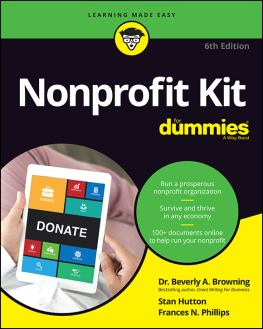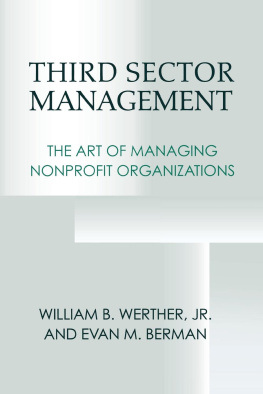
NONPROFIT
TOOLKIT
Dear Reader,
From the title of the book you are holding in your hands, you would think its only a toolkit to guide you through the process of forming and operating a nonprofit organization. It is obviously that, but actually so much more!
This book is about organizing your community group, your garden club, or your performance venue. Its about bringing people in your neighborhood together, even in these challenging economic times, to make their lives and their world a better place. It is about working collectively to understand the confusing layers of detail that are necessary to make sure that your club or community group has the proper systems and groundwork in place. It is about learning to collaborate and to have a good time in the process.
Ive worked with groups all over the country, and Ive seen many people with wonderful ideas become frustrated with the legalese and archaic terminology so often used in nonprofit organizing. The Everything Nonprofit Toolkit is intended to reduce that chatter and to help you and your group gain the confidence and tools necessary to organize a successful nonprofit organization.
Organizing your community and forming a nonprofit organization is a wonderful, exciting process that few people ever experience. I hope this book will help you continue the good work you are doing.
Cheers!


These handy, accessible books give you all you need to tackle a difficult project, gain a new hobby, comprehend a fascinating topic, prepare for an exam, or even brush up on something you learned back in school but have since forgotten.
You can choose to read an Everything book from cover to cover or just pick out the information you want from our four useful boxes: e-questions, e-facts, e-alerts, and e-ssentials. We give you everything you need to know on the subject, but throw in a lot of fun stuff along the way, too.
We now have more than 400 Everything books in print, spanning such wide-ranging categories as weddings, pregnancy, cooking, music instruction, foreign language, crafts, pets, New Age, and so much more. When youre done reading them all, you can finally say you know Everything!

PUBLISHER Karen Cooper
DIRECTOR OF ACQUISITIONS AND INNOVATION Paula Munier
MANAGING EDITOR, EVERYTHING SERIES Lisa Laing
COPY CHIEF Casey Ebert
ASSISTANT PRODUCTION EDITOR Melanie Cordova
ACQUISITIONS EDITOR Kate Powers
ASSOCIATE DEVELOPMENT EDITOR Hillary Thompson
EDITORIAL ASSISTANT Matthew Kane
EVERYTHING SERIES COVER DESIGNER Erin Alexander
LAYOUT DESIGNERS Erin Dawson, Michelle Roy Kelly, Elisabeth Lariviere
Visit the entire Everything series at www.everything.com

NONPROFIT
TOOLKIT
The all-in-one resource for establishing a nonprofit that will grow, thrive, and succeed
Jim Goettler, Author of The Everything Guide to Starting and Running a Nonprofit

This book is dedicated to every person who looks around his or her community of like-minded individuals and picks up the phone, sends an e-mail, or sends a quick text message suggesting that they get together to talk about starting a nonprofit organization. To each of you and to the people with whom you are working, Welcome.
Contents
Acknowledgments
A huge thank-you to a number of people without whom the original The Everything Guide to Starting and Running a Nonprofit, and now The Everything Nonprofit Toolkit would never have come together. First, Verna Dreisbach of Dreisbach Literary Management for sending me a note one fine day asking me if Id like to write a book on nonprofit organizing! Little did I know what an amazing adventure I was agreeing to. Thanks must also go to an excellent copyeditor/proofreader, Jeanine Paquin, who managed to get my tangents cleaned up and the word counts close to target before the folks at Adams Media went to work on the final manuscript that became the book you are now reading. Thank you to copyeditor Robin Witkin for your excellent work. Finally, a thank-you to Goettler Associates in Columbus, Ohio, for kindly sharing a case study of a successful fundraising campaign, which appears in Appendix A of this second edition.
The Top 10 Things Every Organizer of a Nonprofit Must Remember
- Be very careful about the money. Where it comes from and how it is spent will rank among the most important details in your life.
- Never, ever forget why you decided to organize as a nonprofit! Everything in this book is designed to help you do your worknot to become your work.
- Nonprofits are not the magic key to gaining outside funding. In reality, grants are few and far between, and the competition for them is intense.
- The vast majority of new nonprofit organizations fail within two years. This is a simple fact.
- Your board of directors is responsible for the organization. They may not always agree with you, even if you did help start it.
- Nonprofits make communities stronger by bringing people together for a common goal. They can empower communities and all the people working in them.
- A state nonprofit is not the same as a federal nonprofit! If you have not filed for federal tax exemption, you are simply incorporated in your state.
- Never imply you have federal tax exemption or that contributions are tax deductible if you only have state incorporation papers. It just confuses everyone and will cause trouble down the road.
- On the first read, the rules established by the IRS may seem very difficult to understand and follow. However, when you become familiar with them, they will actually help you remember why a nonprofit is different than a for-profit business and will remind you of the wonderful position nonprofits hold in our society.
- If it isnt on paper, it doesnt exist! Record keeping, from the first meeting of your group to all communication with the IRS, must be documented.
Introduction
In 1831, ALEXIS DE TOCQUEVILLE wrote Democracy in America after a nine-month visit to a fledgling nation, the United States. He wrote about the uniquely American phenomenon of forming associations of all types, including professional, social, civil, and political groups.
Today, even in times of economic uncertainty, people continue to organize groups around common interests or professions. The exact makeup of these groups will be as different as their members, but they all share a common characteristic: that is, people coming together to collaborate. The purpose of this book is to provide a solid foundation, indeed a toolkit, for community organizers who work with groups that may be considering formal incorporation in their state or possibly becoming a federally recognized nonprofit.
















